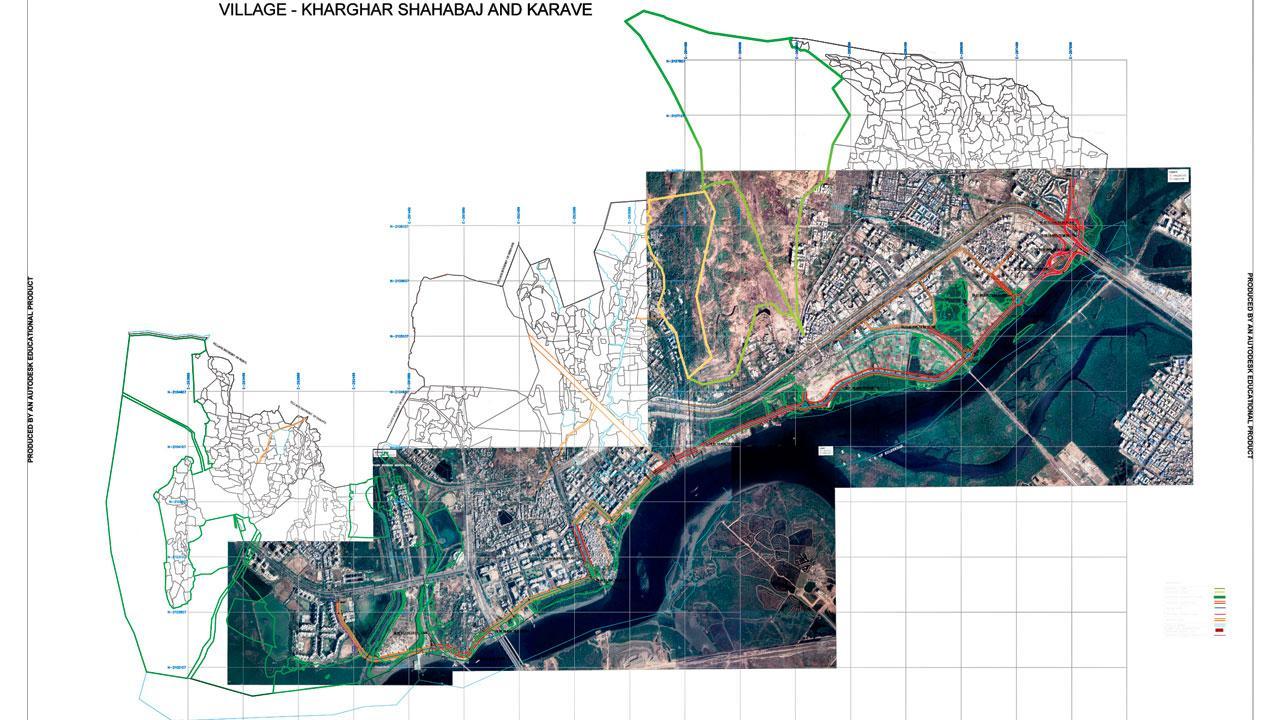According to the proposal sent to the Ministry of Environment, Forest and Climate Change (MOEF&CC) last week, the project involves diversion of 8.222 hectares of forest land. It also involves the use of 30.327 hectares of non-forest land

The proposed road (in red) and the mangrove cover that will be lost (in green)
CIDCO’s Navi Mumbai development plan appears to spell doom for forest land. CIDCO is to construct a coastal road from jalmarg, sector 16 Kharghar to sector 11 in CBD Belapur, and a balance link between sector 15 CBD Belapur and a water transport terminal in Nerul at Navi Mumbai in Thane district.
According to the proposal sent to the Ministry of Environment, Forest and Climate Change (MOEF&CC) last week, the project involves diversion of 8.222 hectares of forest land. It also involves the use of 30.327 hectares of non-forest land.
CIDCO has prepared a Navi Mumbai development plan which covers 95 villages and many well planned and self-sustained nodes, which include Airoli, Ghansoli, Koparkhairane, Vashi, Sanpada, Juinagar, Nerul, Belapur, Kharghar, Kamothe, New Panvel, Kalamboli, Ulwe, Pushpak and Dronagiri.
Also read: Maharashtra: Forest department, NGO save injured leopard cub
Rising population
Initially CIDCO’s focus for development was in Vashi, Sanpada, CBD, Koparkhairane and Airoli. These nodes were developed completely in 1990 and subsequently handed over to Navi Mumbai Municipal Corporation in 1994. This part of Navi Mumbai is referred to as Navi Mumbai (North). Thereafter on arrival of the harbour railway line from Mankhurd to New Panvel in 1990, there was tremendous increase in the population in Navi Mumbai when CIDCO had to shift its development focus to other nodes like Kharghar, Kamothe, New Panvel, Ulwe and Dronagiri. These nodes that come under Raigad district are now referred to as Navi Mumbai (south).
Kharghar node is one of the planned nodes of CIDCO and is supposed to be the most modern. Kharghar is primarily a residential township and has several education institutes in its fold. At present there is only one entry to this node which is known as Pravesh Marg of Kharghar node. The other entry is CBD node via Bharati Vidyapeeth which connects to the Pandav Marg of Kharghar node. There is yet other entry at Kopara village, but it is very narrow and cannot be termed as a permanent entry. So as such there is only one major entry to this node in the form of Pravesh Marg. The coastal road hence aims to provide connectivity.
CIDCO’s justification
CIDCO has justified the project in forest area stating, “The government lands wherein mangroves are found, are to be declared as Protected Forest as per a High Court order. The mangroves forest pockets are scattered near the creeks. As stipulated in the specific condition of the environmental and CRZ clearance, necessary permission of the high court as well as forest department for cutting of mangroves is required to be obtained by CIDCO for the project. The project area is devoid of any rare or endangered flora and fauna.”
CIDCO in its proposal has also stated that efforts were made to re-plan the area excluding the forestland. It said, “It was feared that a major part of the layout may have to be cancelled, hence there appears no option but to include forestland considering unavoidable circumstances. CIDCO was constrained to submit a proposal for diversion of forestland.”
Activist speak
“That’s huge destruction and loss. At a time when we need to preserve and increase the mangrove cover due to coastal land erosion and rising sea levels, we are increasingly working on cutting mangroves. This news, coming as it does on the fourth anniversary of the High Court judgment to conserve mangroves, is terrible,” said B N Kumar, director, NatConnect Foundation.
 Subscribe today by clicking the link and stay updated with the latest news!" Click here!
Subscribe today by clicking the link and stay updated with the latest news!" Click here!










